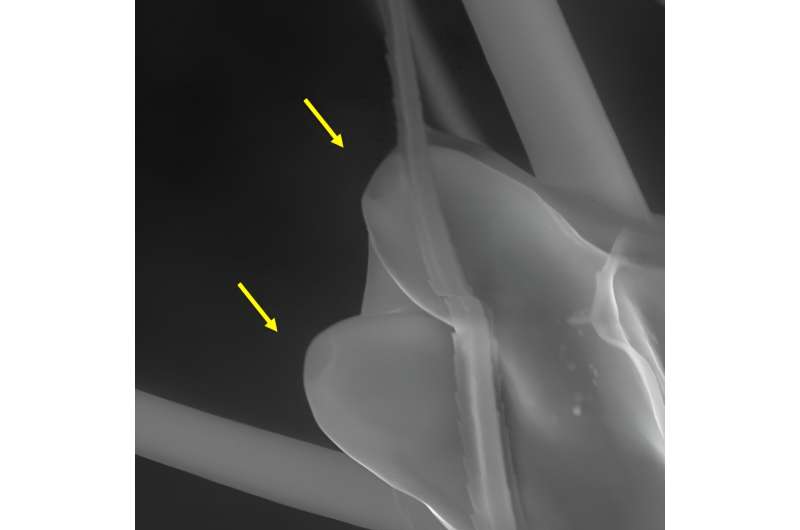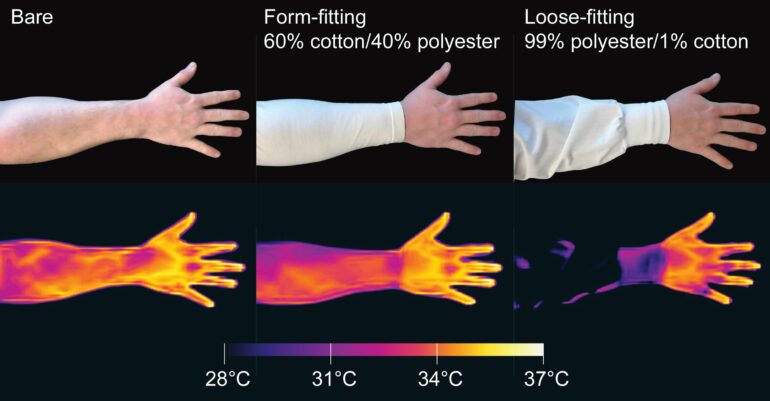While a mosquito bite is often no more than a temporary bother, in many parts of the world it can be scary. One mosquito species, Aedes aegypti, spreads the viruses that cause over 100,000,000 cases of dengue, yellow fever, Zika and other diseases every year. Another, Anopheles gambiae, spreads the parasite that causes malaria. The World Health Organization estimates that malaria alone causes more than 400,000 deaths every year. Indeed, their capacity to transmit disease has earned mosquitoes the title of deadliest animal.
Male mosquitoes are harmless, but females need blood for egg development. It’s no surprise that there’s over 100 years of rigorous research on how they find their hosts. Over that time, scientists have discovered there is no one single cue that these insects rely on. Instead, they integrate information from many different senses across various distances.
A team led by researchers at UC Santa Barbara has added another sense to the mosquito’s documented repertoire: infrared detection. Infrared radiation from a source roughly the temperature of human skin doubled the insects’ overall host-seeking behavior when combined with CO2 and human odor.
The mosquitoes overwhelmingly navigated toward this infrared source while host seeking. The researchers also discovered where this infrared detector is located and how it works on a morphological and biochemical level. The results are detailed in the journal Nature.
“The mosquito we study, Aedes aegypti, is exceptionally skilled at finding human hosts,” said co-lead author Nicolas DeBeaubien, a former graduate student and postdoctoral researcher at UCSB in Professor Craig Montell’s laboratory. “This work sheds new light on how they achieve this.”
Guided by thermal infrared
It is well established that mosquitoes like Aedes aegypti use multiple cues to home in on hosts from a distance. “These include CO2 from our exhaled breath, odors, vision, [convection] heat from our skin, and humidity from our bodies,” explained co-lead author Avinash Chandel, a current postdoc at UCSB in Montell’s group.
“However, each of these cues have limitations.” The insects have poor vision, and a strong wind or rapid movement of the human host can throw off their tracking of the chemical senses. So the authors wondered if mosquitoes could detect a more reliable directional cue, like infrared radiation.
Within about 10 cm, these insects can detect the heat rising from our skin. And they can directly sense the temperature of our skin once they land. These two senses correspond to two of the three kinds of heat transfer: convection, heat carried away by a medium like air, and conduction, heat via direct touch.
But energy from heat can also travel longer distances when converted into electromagnetic waves, generally in the infrared (IR) range of the spectrum. The IR can then heat whatever it hits. Animals like pit vipers can sense thermal IR from warm prey, and the team wondered whether mosquitoes, like Aedes aegypti, could as well.
The researchers put female mosquitoes in a cage and measured their host-seeking activity in two zones. Each zone was exposed to human odors and CO2 at the same concentration that we exhale. However, only one zone was also exposed to IR from a source at skin temperature. A barrier separated the source from the chamber prevented heat exchange through conduction and convection. They then counted how many mosquitoes began probing as if they were searching for a vein.
Adding thermal IR from a 34º Celsius source (about skin temperature) doubled the insects’ host-seeking activity. This makes infrared radiation a newly documented sense that mosquitoes use to locate us. And the team discovered it remains effective up to about 70 cm (2.5 feet).
“What struck me most about this work was just how strong of a cue IR ended up being,” DeBeaubien said. “Once we got all the parameters just right, the results were undeniably clear.”
Previous studies didn’t observe any effect of thermal infrared on mosquito behavior, but senior author Craig Montell suspects this comes down to methodology. An assiduous scientist might try to isolate the effect of thermal IR on insects by only presenting an infrared signal without any other cues.
“But any single cue alone doesn’t stimulate host-seeking activity. It’s only in the context of other cues, such as elevated CO2 and human odor that IR makes a difference,” said Montell, the Duggan and Distinguished Professor of Molecular, Cellular, and Developmental Biology. In fact, his team found the same thing in tests with only IR: infrared alone has no impact.
A trick for sensing infrared
It isn’t possible for mosquitoes to detect thermal infrared radiation the same way they would detect visible light. The energy of IR is far too low to activate the rhodopsin proteins that detect visible light in animal eyes. Electromagnetic radiation with a wavelength longer than about 700 nanometers won’t activate rhodopsin, and IR generated from body heat is around 9,300 nm. In fact, no known protein is activated by radiation with such long wavelengths, Montell said. But there is another way to detect IR.
Consider heat emitted by the sun. The heat is converted into IR, which streams through empty space. When the IR reaches Earth, it hits atoms in the atmosphere, transferring energy and warming the planet. “You have heat converted into electromagnetic waves, which is being converted back into heat,” Montell said. He noted that the IR coming from the sun has a different wavelength from the IR generated by our body heat, since the wavelength depends on the temperature of the source.
The authors thought that perhaps our body heat, which generates IR, might then hit certain neurons in the mosquito, activating them by heating them up. That would enable the mosquitoes to detect the radiation indirectly.
Scientists have known that the tips of a mosquito’s antennae have heat-sensing neurons. And the team discovered that removing these tips eliminated the mosquitoes’ ability to detect IR.
Indeed, another lab found the temperature-sensitive protein, TRPA1, in the end of the antenna. And the UCSB team observed that animals without a functional trpA1 gene, which codes for the protein, couldn’t detect IR.
The tip of each antenna has peg-in-pit structures that are well adapted to sensing radiation. The pit shields the peg from conductive and convective heat, enabling the highly directional IR radiation to enter and warm up the structure. The mosquito then uses TRPA1—essentially a temperature sensor—to detect infrared radiation.

Pits at the end of the mosquito’s antennae shield the peg-like structures that detect thermal IR. © DeBeaubien and Chandel et al.
Diving into the biochemistry
The activity of the heat-activated TRPA1 channel alone might not fully explain the range over which mosquitoes were able to detect IR. A sensor that exclusively relied on this protein may not be useful at the 70 cm range the team had observed. At this distance there likely isn’t sufficient IR collected by the peg-in-pit structure to heat it enough to activate TRPA1.
Fortunately, Montell’s group thought there might be more sensitive temperature receptors based on their previous work on fruit flies in 2011. They had found a few proteins in the rhodopsin family that were quite sensitive to small increases in temperature.
Although rhodopsins were originally thought of exclusively as light detectors, Montell’s group found that certain rhodopsins can be triggered by a variety of stimuli. They discovered that proteins in this group are quite versatile, involved not just in vision, but also in taste and temperature sensing. Upon further investigation, the researchers discovered that two of the 10 rhodopsins found in mosquitoes are expressed in the same antennal neurons as TRPA1.
Knocking out TRPA1 eliminated the mosquito’s sensitivity to IR. But insects with faults in either of the rhodopsins, Op1 or Op2, were unaffected. Even knocking out both the rhodopsins together didn’t entirely eliminate the animal’s sensitivity to IR, although it significantly weakened the sense.
Their results indicated that more intense thermal IR—like what a mosquito would experience at closer range (for example, around 1 foot)—directly activates TRPA1. Meanwhile, Op1 and Op2 can get activated at lower levels of thermal IR, and then indirectly trigger TRPA1. Since our skin temperature is constant, extending the sensitivity of TRPA1 effectively extends the range of the mosquito’s IR sensor to around 2.5 ft.
A tactical advantage
Half the world’s population is at risk for mosquito-borne diseases, and about a billion people get infected every year, Chandel said. What’s more, climate change and worldwide travel have extended the ranges of Aedes aegypti beyond tropical and subtropical countries. These mosquitoes are now present in places in the US where they were never found just a few years ago, including California.
The team’s discovery could provide a way to improve methods for suppressing mosquito populations. For instance, incorporating thermal IR from sources around skin temperature could make mosquito traps more effective. The findings also help explain why loose-fitting clothing is particularly good at preventing bites. Not only does it block the mosquito from reaching our skin, it also allows the IR to dissipate between our skin and the clothing so the mosquitoes cannot detect it.
“Despite their diminutive size, mosquitoes are responsible for more human deaths than any other animal,” DeBeaubien said. “Our research enhances the understanding of how mosquitoes target humans and offers new possibilities for controlling the transmission of mosquito-borne diseases.”
In addition, to the Montell team, Vincent Salgado, formerly at BASF, and his student, Andreas Krumhotz, contributed to this study.
More information:
Craig Montell, Thermal infrared directs host-seeking behaviour in Aedes aegypti mosquitoes, Nature (2024). DOI: 10.1038/s41586-024-07848-5. www.nature.com/articles/s41586-024-07848-5
Provided by
University of California – Santa Barbara
Citation:
Mosquitoes sense infrared from body heat to help track humans down, study shows (2024, August 22)



